1810s
This articleneeds additional citations forverification.(December 2010) |

| Millennium |
|---|
| 2nd millennium |
| Centuries |
| Decades |
| Years |
| Categories |
The1810s(pronounced "eighteen-tens" ) was adecadeof theGregorian calendarthat began on January 1, 1810, and ended on December 31, 1819.
The decade was opened with a very hostile political climate around the world.Napoleonwas invading France's neighbours in efforts to build aFrench Empire,causing a chain of global-scaled conflicts known as theNapoleonic Wars.Here, France's Napoleonic empire saw its rise and fall through events such asNapoleon's attempts to conquer Russia,theWar of 1812(spillover to America), and theBattle of Waterloo(Napoleon's ultimate defeat).Imperialismbegan to encroach towards African and Asian territories through trade, as the United States saw mass-scaled migration that headedwestward towards the American frontier(mostly through the opening of theOregon Trail.)
Politics and wars[edit]
Napoleonic Wars[edit]

In 1810, the French Empire reached its greatest extent. On the continent, the British and Portuguese remained restricted to the area aroundLisbonand tobesieged Cadiz.Napoleon marriedMarie-Louise,an Austrian Archduchess, with the aim of ensuring a more stable alliance with Austria and of providing the Emperor with an heir. As well as the French Empire, Napoleon controlled the Swiss Confederation, the Confederation of the Rhine, the Duchy of Warsaw and the Kingdom of Italy. Territories allied with the French included: the Kingdom of Spain, theKingdom of Westphalia,the Kingdom of Naples, thePrincipalityof Lucca and Piombino, and Napoleon's former enemies, Prussia and Austria.Denmark–Norwayalso allied with France in opposition to Great Britain and Sweden in theGunboat War.
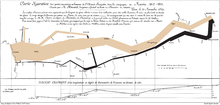
TheFrench invasion of Russiaof 1812 was a turning point, which reduced theFrenchand allied invasion forces (theGrande Armée) to a tiny fraction of their initial strength and triggered a major shift in European politics, as it dramatically weakened the previously dominant French position on the continent. After the disastrous invasion of Russia, a coalition ofAustria,Prussia,Russia,Sweden, theUnited Kingdom,and a number ofGerman States,and the rebels inSpainandPortugalunited to battle France in theWar of the Sixth Coalition.Two-and-a-half million troops fought in the conflict and the total dead amounted to as many as two million. This era included the battles ofSmolensk,Borodino,Lützen,Bautzen,and theDresden.It also included the epicBattle of Leipzigin October, 1813 (also known as the Battle of Nations), which was the largest battle of the Napoleonic wars, which drove Napoleon out of Germany.

The final stage of the War of the Sixth Coalition, the defense of France in 1814, saw the French Emperor temporarily repulse the vastly superior armies in theSix Days Campaign.Ultimately, the Allies occupied Paris, forcing Napoleon to abdicate andrestoring the Bourbons.Napoleon was exiled toElba.Also in 1814, Denmark–Norway was defeated by Great Britain and Sweden and had to cede the territory of mainland Norway to the King of Sweden at theTreaty of Kiel.
Napoleon shortly returned from exile, landing in France on March 1, 1815, marking theWar of the Seventh Coalition,heading toward Paris while theCongress of Viennawas sitting. On March 13, seven days before Napoleon reached Paris, the powers at the Congress of Viennadeclared him an outlaw;four days later theUnited Kingdom,Russia,AustriaandPrussia,members of theSeventh Coalition,bound themselves to put 150,000 men each into the field to end his rule.[1]This set the stage for the last conflict in theNapoleonic Wars,the defeat of Napoleon at theBattle of Waterloo,the restoration of the French monarchy for the second time and the permanent exile of Napoleon to the distant island ofSaint Helena,where he died in May 1821.
Spanish American wars of independence[edit]
Spain in the 1810s was a country in turmoil. Occupied byNapoleonfrom 1808 to 1814, a massively destructive "war of independence"ensued, driven by an emergent Spanishnationalism.Already in 1810, theCaracasandBuenos Airesjuntas declared their independence from the Bonapartist government in Spain and sent ambassadors to the United Kingdom. The Britishblockadeagainst Spain had also moved most of the Latin American colonies out of the Spanish economic sphere and into the British sphere, with whom extensive trade relations were developed. The remaining Spanish colonies had operated with virtual independence from Madrid after their pronouncement against Joseph Bonaparte.
The Spanish government in exile (Cortes of Cádiz) created the first modernSpanish constitution.Even so, agreements made at theCongress of Vienna(where Spain was represented byPedro Gómez Labrador, Marquis of Labrador) would cement international support for the old,absolutistregime in Spain.
KingFerdinand VII,who assumed the throne after Napoleon was driven out of Spain, refused to agree to theliberalSpanish Constitution of 1812on his accession to the throne in 1814. TheSpanish Empirein the New World had largely supported the cause of Ferdinand VII over the Bonapartist pretender to the throne in the midst of theNapoleonic Wars.When Ferdinand's rule was restored, these juntas were cautious of abandoning their autonomy, and an alliance between local elites, merchant interests, nationalists, and liberals opposed to the abrogation of the Constitution of 1812 rose up against the Spanish in the New World.

The arrival of Spanish forces in the American colonies began in 1814, and was briefly successful in restoring central control over large parts of the Empire.Simón Bolívar,the leader of revolutionary forces inNew Granada,was briefly forced into exile in British-controlledJamaica,and independentHaiti.In 1816, however, Bolivar found enough popular support that he was able to return to South America, and in a daring march from Venezuela to New Granada (Colombia), he defeated Spanish forces at theBattle of Boyacáin 1819, ending Spanish rule in Colombia.Venezuelawas liberated June 24, 1821, when Bolivar destroyed the Spanish army on the fields of Carabobo on the Battle of Carabobo.Argentinadeclared its independence in 1816 (though it had been operating with virtual independence as a British client since 1807 after successfullyresisting a British invasion).Chilewas retaken by Spain in 1814, but lost permanently in 1817 when an army underJosé de San Martín,for the first time in history, crossed theAndes Mountainsfrom Argentina to Chile, and went on to defeat Spanish royalist forces at theBattle of Chacabucoin 1817.
Spain would also loseFloridato the United States during this decade. First, in 1810, theRepublic of West Floridadeclared its independence from Spain, and was quickly annexed by the United States. Later, in 1818, the United States invaded Florida, resulting in theAdams-Onís Treaty,wherein Spain ceded the rest of Florida to the United States.
In 1820,Mexico,Peru,Ecuador,andCentral Americastill remained under Spanish control. AlthoughMexicohad been in revolt in 1811 underMiguel Hidalgo y Costilla,resistance to Spanish rule had largely been confined to smallguerrillabands in the countryside. King Ferdinand was still dissatisfied with the loss of so much of the Empire and resolved to retake it. A large expedition was assembled inCadizwith the aim of reconquest. However, Ferdinand's plans would be disrupted byLiberal Revolution,and Ferdinand was eventually forced to give up all of the New World colonies, except forCubaandPuerto Rico.
War of 1812[edit]
In 1812, the United States declared war onBritainin theWar of 1812.The U.S. reasons for war included the humiliation in the"Chesapeake incident" of 1807,continued Britishimpressmentof American sailors into theRoyal Navy,restrictions on trade with France, and arming hostile American Indians in Ohio and the western territories.[2]United States PresidentJames Madisonsigned a declaration of war on June 18, 1812.
The United States conducted two failed invasion attempts in 1812, first by GeneralWilliam Hullacross theDetroit Riverinto what is nowWindsor, Ontario,and a second offensive at theNiagara peninsula.A major American success came in 1813, when the American Navy destroyed the British fleet on Lake Erie, and forced the British and their American Indian allies to retreat back toward Niagara.[3]They were intercepted and destroyed by GeneralWilliam Henry Harrisonat theBattle of the Thamesin October 1813.Tecumseh,the leader of the tribal confederation, was killed, and his Indian coalition disintegrated.[4]
At sea, the powerfulRoyal Navyblockaded much of the coastline, conducting frequent raids. The most famous episode was a series of British raids on the shores ofChesapeake Bay,including an attack on Washington that resulted in the British burning of theWhite House,theCapitol,theNavy Yard,and other public buildings, in the "Burning of Washington"in 1814.
Once Napoleon was defeated in 1814, France and Britain became allies and Britain ended the trade restrictions and the impressment of American sailors. Running out of reasons for war and stuck in a military stalemate, the two countries signed theTreaty of Ghenton December 24, 1814. News of the peace treaty took two months to reach the U.S., during which fighting continued. In this interim, the British made one last major invasion, attempting to capture New Orleans, but were decisively defeated with very heavy losses by General Andrew Jackson at theBattle of New Orleansin January 1815. The ending of the war opened a long era of peaceful relations between the United States and the British Empire.
1804–1813 Russo-Persian War[edit]
The1804–1813 Russo-Persian Warwas one of the many wars between thePersian EmpireandImperial Russia,and was well underway at the beginning of the decade. In 1810, the Persians scaled up their efforts late in the war, declaring a holy war on Imperial Russia. However, Russia's superior technology and tactics ensured a series of strategic victories. Even when the French were in occupation of the Russian capital Moscow, Russian forces in the south were not recalled but continued their offensive against Persia, culminating inPyotr Kotlyarevsky's victories atAslanduzandLenkoran,in 1812 and 1813 respectively. Upon the Persian surrender, the terms of theTreaty of Gulistanceded the vast majority of the previously disputed territories to Imperial Russia. This led to the region's once-powerfulkhansbeing decimated and forced to pay homage to Russia.
Concert of Europe[edit]
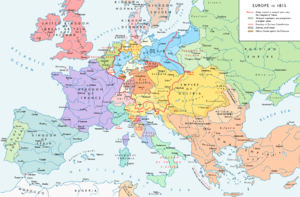
By 1815, Europe had been almost constantly at war. During this time, the military conquests of France had resulted in the spread ofliberalismthroughout much of the continent, resulting in many states adopting theNapoleonic code.Largely as a reaction to the radicalism of theFrench Revolution,[5]the victorious powers of theNapoleonic Warsresolved to suppress liberalism andnationalism,and revert largely to thestatus quoof Europe prior to 1789.[6]
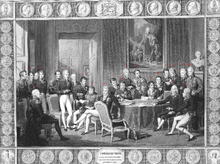
The result was theConcert of Europe,also known as the "Congress System". It was thebalance of powerthat existed in Europe from 1815 until the early 20th century. Its founding members were theUnited Kingdom,Austrian Empire,Russian EmpireandKingdom of Prussia,the members of theQuadruple Allianceresponsible for the downfall of theFirst French Empire;in time France became established as a fifth member of the concert. At first, the leading personalities of the system were British foreign secretaryLord Castlereagh,Austrian chancellorKlemens Wenzel, Prince von MetternichandTsarAlexander I of Russia.
TheKingdom of Prussia,Austrian EmpireandRussian Empireformed theHoly Alliancewith the expressed intent of preservingChristiansocial values and traditionalmonarchism.[7]Every member of the coalition promptly joined the Alliance, save for theUnited Kingdom.
Among the meetings of the Powers in the latter part of the 1810s were the Congresses ofVienna(1814–1815),Aix-la-Chappelle(1818), andCarlsbad(1819).
Other political events[edit]
Australia[edit]
- Black War(1804–1835)
- Hawkesbury and Nepean Wars(1795–1816)
Asia[edit]
- 1810:Ching ShihandChang Paosurrender their pirate fleet to the Chinese government.
- 1810: Russia acquiresSukhumithrough a treaty with theAbkhaziandukes, and declares aprotectorateover the whole ofAbkhazia.
- Russo-Turkish War (1806–1812)
- May 28, 1812 – Russian field marshalMikhail Kutuzovsigns theTreaty of Bucharest,ending theRusso-Turkish War, 1806–1812and makingBessarabiaa part ofImperial Russia.
- October 31, 1817 –Emperor Ninkōaccedes to the throne of Japan.
- 1818: TheThird Anglo-Maratha Waris fought between theMarathasand theBritish East India Companytroops resulting in the defeat of thePeshwa,the breakup of theMaratha Empire,and the loss of Maratha independence to the British as they annexed Central India. The last Peshwa is exiled to Bithur near Kanpur. His adopted son and heirNana Sahebwas one of the principal revolutionary commanders in theIndian Mutiny.
Europe[edit]
- August 21, 1810 –Jean-Baptiste Bernadotte,Marshal of France,is electedCrown Princeof Sweden by the SwedishRiksdag of the Estates.
- September 26, 1810 – A newAct of Successionis adopted by theRiksdag of the EstatesandJean Baptiste Bernadottebecomes heir to theSwedishthrone.
- October 12, 1810 – FirstOktoberfest:TheBavarianroyalty invites the citizens ofMunichto join the celebration of the marriage ofCrown Prince Ludwig of BavariatoPrincessTherese of Saxe-Hildburghausen.
- February 5, 1811 –British Regency:George, Prince of Walesbecomesprince regentbecause of the perceived insanity of his father, KingGeorge III of the United Kingdom.
- September, 1811 –Nathan of Breslovleads the first annualRosh Hashana kibbutz(pilgrimage) ofBreslovHasidim to the grave ofRabbi Nachman of BreslovinUman, Ukraine.
- January 1, 1812 – TheAllgemeines bürgerliches Gesetzbuch(the Austriancivil code) enters into force in theAustrian Empire.
- May 11, 1812 –John BellinghamassassinatesBritishPrime MinisterSpencer Percevalin the lobby of theBritish House of Commons.
- July 18, 1812 –Russia's Patriotic War,1812 –Battle of Klyastitsy:KulnevdefeatsOudinotbut sustains a mortal wound.
- October 18–October 20, 1812 –Second Battle of Polotsk– Russia
- December 30, 1812 –Convention of Tauroggenwas signed.
- 1812 – Thecapitalof Finland is moved fromTurkutoHelsinki.
- November 10, 1813 – Ageneral electionin the United Kingdom sees victory for theToryParty underRobert Jenkinson, 2nd Earl of Liverpool.
- 1813 –George Hamilton-Gordonserves as ambassador extraordinaire inVienna.
- Norway in 1814
- January 14, 1814 – Denmark cedes Norway to Sweden in exchange for westPomerania,as part of theTreaty of Kiel.
- February 11, 1814 – Norway's independence is proclaimed, marking the ultimate end of theKalmar Union.
- April 12, 1814 – TheRoyal Norwegian Navyis re-established.
- May 17, 1814 – TheConstitution of Norwayis signed and theDanishCrown PrinceChristian Frederikis electedKing of Norwayby theNorwegian Constituent Assembly.
- May 3, 1814 – TheDuke of Provence,the futureLouis XVIII of France,returns to Paris.
- May 17, 1814 – TheoccupationofMonacochanges from French to Austrian hands.
- May 30, 1814 – TheFirst Treaty of Parisis signed returning France's borders to their 1792 extent.Napoleon I of Franceis exiled toElbaon the same day.
- August 12, 1814 – In England, the last hanging under theBlack Actis carried out, of William Potter for cutting down anorchard(even thejudgepetitioned for reprieve).
- August 13, 1814 – TheAnglo-Dutch Treaty of 1814is signed.
- January 3, 1815 –Austria,Britain, and Bourbon-restored France form a secret defensive alliance treaty againstPrussiaand Russia.
- March 15, 1815 –Joachim Murat,King of Naplesdeclares war onAustriain an attempt to save his throne, starting theNeapolitan War.
- March 16, 1815 –William IbecomesKing of the Netherlands.
- April 23, 1815 – TheSecond Serbian UprisingagainstOttomanrule takes place inTakovo,Serbia.By the end of the yearSerbiais acknowledged as a semi-independent state; the ideals of theFirst Serbian Uprisinghave thus been temporarily achieved.
- May 3, 1815 –Battle of Tolentino:Austriadefeats theKingdom of Naples,which quickly ends theNeapolitan War.Joachim Murat,the defeated King of Naples, is forced to flee toCorsicaand is later executed.
- 1815: In Britain, use of thepilloryis limited to punishment forperjury.
- January 1, 1816 –TsarAlexander I of Russiasigns an order for the expulsion of theJesuitsfrom the Russian Empire.
- March 25, 1816 –Friedrich Karl Ludwig, Duke of Schleswig-Holstein-Sonderburg-Beckdies and is succeeded by the laterFriedrich Wilhelm, Duke of Schleswig-Holstein-Sonderburg-Glücksburg,his son and founder of theSchleswig-Holstein-Sonderburg-Glücksburg.
- 1816: TheSenate of Finlandis established.
- 1816: TheOttomansgrantSerbialocalautonomy.
- April 3, 1817 –Princess Carabooappears inAlmondsburyinGloucestershire,England.
- May 11, 1818 –Charles XIVofSweden-Norwayis crowned king of Sweden.
- September 7, 1818 –Carl IIIofSweden-Norwayis crowned king of Norway, inTrondheim.
- September 23, 1818 – Border markers are formally installed for the European territory ofMoresnet.
- September 20, 1819 – TheCarlsbad Decreeis issued throughout theGerman Confederation.
Africa[edit]
- 1810:Amadou Lobboinitiates hisjihadin present-dayMali.
- 1810: The Battle of Vieux Grand Port (Great Old Port) in the Indian Ocean, off the coast of the Island of Mauritius, was the only naval victory won by Napoleon. This battle has very often been ignored by scholars, but was of great importance for the control of the Indian Ocean as a trade route between Europe and the East.
- March 1, 1811 –Citadel Massacre:EgyptianrulerMohammed Alikills the lastMamlukleaders.
- 1813: Following the death of his fatherWossen Seged,Sahle Selassiearrives at the capital Qundi before his other brothers, and is made Méridazmach ofShewa.
- 1816:Banjul,capital ofthe Gambia,is founded as a trading post, and named Bathurst.
- August 27, 1816 –Bombardment of Algiers:Various European Allie ships force theDey of Algiersto free Christian slaves.
- 1818:Shakastarts to rule.
- Mtetwa EmpireExpansion
North America[edit]
- May 1, 1810 –Macon's Bill Number 2becomes law.
- June 4, 1810 –The Society in Dedham for Apprehending Horse Thievesis founded inDedham, Massachusetts.
- 1811: TheRed River Colonyis founded inManitoba,Canada.
- March 22, 1811 – TheCommissioners' Plan of 1811for Manhattan is presented.
- November 7, 1811 –Battle of Tippecanoe:American troops led byWilliam Henry Harrisondefeat theNative Americanchief Tecumseh.
- February 11, 1812 –MassachusettsgovernorElbridge Gerryinventsgerrymandering.
- April 4, 1812 –U.S. PresidentJames Madisonenacts a 90-dayembargoon trade with the United Kingdom.
- April 30, 1812 –Louisianais admitted as the 18thU.S. state.
- June 4, 1812 – FollowingLouisiana's admittance as aU.S. state,the territory by that name is renamed theMissouri Territory.
- October 1812 – The capital of thePennsylvania,United States is permanently moved fromLancastertoHarrisburg.
- November 5, 1812 –James MadisondefeatsDeWitt Clintonin theU.S. presidential election.
- March 27, 1814 –Creek War–Battle of Horseshoe Bend:In northernAlabama,United States forces under GeneralAndrew Jacksondefeat theCreekIndians.
- December 15, 1814 – TheHartford Conventionis convened by members of the AmericanFederalist Party.
- February – TheHartford Conventionarrives in Washington, D.C..
- August 24, 1816 – TheTreaty of St. Louisis signed inSt. Louis, Missouri.
- November 6, 1816 –James MonroedefeatsRufus Kingin theU.S. presidential election.
- December 11, 1816 –Indianais admitted as the 19thU.S. state.
- 1816: TheSecond Bank of the United Statesobtains its charter.
- TheEra of Good Feelings(1816–1823/1824) in the U.S.
- March 3
- PresidentJames MadisonvetoesJohn C. Calhoun'sBonus Bill.
- U.S. Congress passes law to split theMississippi Territory,after Mississippi drafts a constitution, creating theAlabama Territoryeffective in August.[8]
- March 4, 1817 –James MonroesucceedsJames Madisonas President of the United States of America.
- April 29, 1817 – TheRush–Bagot Treatyis signed.
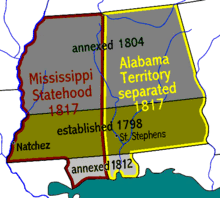
Dec. 10:Mississippistatehood.
- August 15, 1817 – By act of the U.S. Congress (March 3), theAlabama Territoryis created by splitting theMississippi Territoryin half, on the day the Mississippi constitution is drafted, 4 months beforeMississippibecomes a U.S. state.[8]
- November 20, 1817 – TheFirst Seminole Warbegins inFlorida.
- December 10, 1817 –Mississippiis admitted as the 20thU.S. state,formerly theMississippi Territory.[8]
- April 4, 1818 – TheU.S. Congressadopts theflag of the United Statesas having 13 red and white stripes and one star for each state (20 stars) with additional stars to be added whenever a new state is added to the Union.
- August 1, 1818 – SeparateTopographical Bureauof theWar Department.
- October 20, 1818 – TheTreaty of 1818between the United States and the United Kingdom establishes the northern boundary as the 49th parallel from theLake of the Woodsto theRocky Mountains,also creating theNorthwest Angle.
- December 3, 1818 –Illinoisis admitted as the 21stU.S. state.
- February 2, 1819 – The Supreme Court underJohn Marshallrules in favor ofDartmouth Collegein the famousDartmouth College v. Woodwardcase, allowing Dartmouth to keep its charter and remain a private institution.
- March 6, 1819 –McCulloch v. Maryland:TheU.S. Supreme Courtrules that theBank of the United Statesis constitutional.
- 1819: TheʻAi Noamovement takes power inHawaii.
- The city of Fernandina of Jagua (later Cienfuegos City) is founded inCuba.
- December 14, 1819 –Alabamais admitted as the 22ndU.S. state.
South America[edit]
- 1814:Guyanais transferred from the Netherlands to Britain; it is renamedBritish Guiana.
- August 22, 1817 – The city ofAraraquara,Brazil is founded.
- The SpanishcolonyofNew Granadadeclares independence as theRepublic of Gran Colombiaunder PresidentSimón Bolívar(1800–1900)* Stars the period ofLatin American revolutions.Several states declare their independence from Spain.
- 1817: ThePernambucan Revoltbreaks out in Brazil.
Commerce[edit]
Trading companies[edit]
- June 23, 1810 –John Jacob Astorforms thePacific Fur Company.
- September 8, 1810 – TheTonquinsets sail fromNew York Harborwith 33 employees ofJohn Jacob Astor's newly createdPacific Fur Companyon board. After a 6-month journey around the tip of South America, the ship arrives at the mouth of theColumbia Riverand Astor's men establish the fur-trading town ofAstoria.
- 1810:Palm oilsales from West Africa to Britain reach 1,000 tons.
- February 2, 1812 – Russia establishes a fur trading colony atFort Ross, California.
- June 19, 1816 –Battle of Seven Oaks:TheHudson's Bay Companyis defeated by theNorth West Fur-Trading Company,nearWinnipeg,Manitoba,Canada.
- 1818:Lord Hastings,governor-generalof India, gives approval toSirStamford Rafflesto establish trading station at the southern tip of theMalay Peninsula(modern-daySingapore).
- 1818: TheBritish East India Companycontrols territory occupied by 180 millionIndians.
- January 29, 1819 – SirStamford Raffleslands on the island ofSingapore.
- February 6, 1819 – A formal treaty betweenHussein Shah of Johorand the British SirThomas Stamford Rafflesestablishes a trading settlement inSingapore.
Establishments[edit]
- 1812: The Old Oscar Pepper Distillery (now theWoodford Reserve Distillery), the oldestKentuckyBourbondistillery,is established alongGlenn's CreekinWoodford County, Kentucky.
- February 3, 1815 – The first commercialcheesefactory is founded in Switzerland.
- 1816:E. Remington and Sons(the famous firearm and later typewriter manufacturing company) is founded.
- April 7, 1818 –Brooks Brothers,the oldest men's clothier in the United States, opens its first store on the northeast corner of Catherine and Cherry Streets in New York City, where theSouth Street Seaportnow stands.
- March 20, 1819 –Burlington Arcadeopens in London.
Slavery, Serfdom and Labor[edit]
- 1810: Adult cotton spinners stage ageneral strikeinManchester.
- 1810: 18,000Angolansare sold atRio de Janeiro,Brazil.
- January 8, 1811 – An unsuccessful slave revolt is led byCharles Deslandesin St. Charles and St. James Parishes,Louisiana.
- March 23, 1816 –Estoniaemancipates its peasants fromserfdom.
- February 15, 1819 – TheUnited States House of Representativesagrees to the Tallmadge Amendment barring slaves from the new state of Missouri (the opening vote in a controversy that leads to theMissouri Compromise).
- August 16, 1819 –Peterloo Massacre:The cavalry charges into a crowd of protesters inManchester,UK, resulting in 11 deaths and over 400 injuries.
- 1819:Serfdomis abolished inLivonia.
Luddites[edit]
- TheLuddites(1811–1816) in Britain were machine-wreckers, protesting against machines perceived as taking their jobs.
- November, 1811 –Ludditeuprisings begin in northern England and theMidlands.
- February 27, 1812 –PoetLord Byrongives his first address as a member of theHouse of Lords,in defense ofLudditeviolence againstIndustrialismin his home county ofNottinghamshire.
- March 15, 1812 –Ludditesattack thewoolprocessing factory ofFrank VickermaninWest Yorkshire.
Economics[edit]
- February 21, 1814 –Great Stock Exchange Fraud of 1814.
- January 2, 1819 – ThePanic of 1819(the first majorfinancial crisisin the United States) begins.
Science and technology[edit]
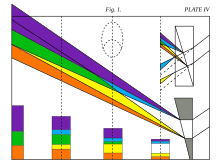
- Gas lightingbecomes a practical technology and is implemented in cities in Europe and the United States.
- June –Nicolas AppertpublishesL'art de conserver pendant plusieurs années toutes les substances animales ou végétales,the first description of modernfood preservationusing airtight containers
- 1810:Johann Wolfgang von Goethepublishes hisTheory of Colours.
- July 11, 1811 – Italian scientistAmedeo Avogadropublishes his memoire about the molecular content of gases.
- February 12, 1812 –Napoleonauthorizes the usage of "Mesures usuelles",a system ofmeasurementintroduced as compromise between themetric systemand traditional French measurements. The system was restricted to use in the retail industry and continued in use until 1840, when the laws of measurement from the 1795 and 1799 were reinstituted. (see also:Units of measurement in France)
- 1813:Mathieu Orfilapublishes his groundbreakingTraité des poisons,formalizing the field oftoxicology.
- October 21, 1815 –Humphry Davypatents theminer's safety lampfor use incoalmining.
- January 9, 1816 – SirHumphry Davytests theDavy lampfor Miners atHebburnColliery.
- 1816 –René Laennecinvents thestethoscope.
- 1816 –Robert StirlingpatentshisStirling engine,then known as Stirling's air engine.
- John Kiddextractsnaphthalenefromcoaltar.
Astronomy[edit]
- March 25,1811– TheGreat Comet of 1811is discovered byHonoré Flaugergues.
- July 1,1819–Johann Georg Trallesdiscovers theGreat Comet of 1819,(C/1819 N1). It was the first comet analyzed usingpolarimetry,byFrançois Arago.
Steamboats[edit]

The 1810s continued a trend of increasing commercial viability ofsteamboatsin North America, following the early success ofRobert Fultonand others in the preceding years. In 1811 the first in a continuously operating line of river steamboats left the dock atPittsburghto steam down theOhio Riverto theMississippiand on toNew Orleans.[9]InventorJohn Stevens' boat, theJuliana,began operation as the firststeam-poweredferryOctober 11, 1811, with service betweenNew York,andHoboken, New Jersey.John Molson'sPSAccommodationwas the first steamboat on theSt. Lawrenceand in Canada.[10]Unlike Fulton, Molson did not show a profit. Molson had also two paddle steamboats "Swiftsure" of 1811 and "Malsham" of 1813 with engines by B&W.[11]The experience of these vessels, especially that they could now offer a regular service, being independent of wind and weather, helped make the new system of propulsion commercially viable, and as a result its application to the more open waters of theGreat Lakeswas next considered. That idea went on hiatus due to theWar of 1812.
In a 25-day trip in 1815, theEnterprisefurther demonstrated the commercial potential of the steamboat with a 2,200-mile voyage fromNew OrleanstoPittsburgh.[12][13]In 1817, a consortium inSackets Harbor, New York,funded the construction of the first US steamboat,Ontario,to run onLake Ontarioand theGreat Lakes,beginning the growth of lake commercial and passenger traffic.[14]
The first commercially successful steamboat in Europe,Henry Bell'sCometof 1812, started a rapid expansion of steam services on theFirth of Clyde,and within four years a steamer service was in operation on the inlandLoch Lomond,a forerunner of the lake steamers still gracing Swiss lakes. On the Clyde itself, within ten years ofComet'sstart in 1812 there were nearly fifty steamers, and services had started across theIrish SeatoBelfastand on many British estuaries. P.S. "Thames", ex "Argyle" was the first seagoing steamer in Europe, having steamed from Glasgow to London in May 1815.[15]P.S. "Tug", the first tugboat, was launched by the Woods Brothers, Port Glasgow, on November 5, 1817; in the summer of 1817 she was the first steamboat to travel round the North of Scotland to the East Coast.[16]
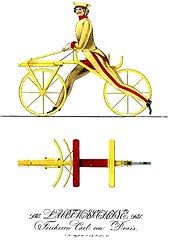
The first steamship credited with crossing the Atlantic Ocean between North America and Europe was the American shipSS Savannah,though she was actually a hybrid between a steamship and a sailing ship. TheSS Savannahleft the port ofSavannah, Georgia,on May 22, 1819, arriving inLiverpool,England, on June 20, 1819; her steam engine having been in use for part of the time on 18 days (estimates vary from 8 to 80 hours).
Locomotives[edit]
- July 25, 1814 –George Stephensontests hislocomotiveBluchersuccessfully.
- February 6, 1815 –New Jerseygrants the first Americanrailroadcharter to aJohn Stevens.
- 1816: Arailcapable of supporting a heavylocomotiveis developed.
Other transportation[edit]
- July 4, 1817 – AtRome, New York,construction on theErie Canalbegins.
- 1818 - BaronKarl Draispatents thelaufmaschine,a forerunner to thebicycle
Natural events[edit]
- December 16, 1811 – TheNew Madrid earthquakeinMississippi ValleynearNew Madridreverses the course of the river for a while. Other earthquakes along the fault occur on January 23, 1812, and February 7, 1812.
- February 7, 1812 – The lastNew Madrid earthquakestrikesNew Madrid, Missouri,with an estimatedmoment magnitudeof over 8;
- March 26, 1812 – AnearthquakedestroysCaracas,Venezuela.
- April, 1817 – AnearthquakestrikesPalermo,Italy.
- August 23, 1817 – An earthquake near the site of the ancient Greek city ofHelikeresults in 65 deaths.
Year Without a Summer[edit]

- April 5–April 12, 1815 –Mount Tamborain theDutch East Indiesblows its top explosively during an eruption, killing upwards of 92,000 and propelling thousands of tons of aerosols (Sulfidegas compounds) into the upper atmosphere (stratosphere). The following year (1816) becomes known as "Year Without a Summer", as the high level gases reflect sunlight and cause the widespread cooling (known as avolcanic winter) and heavy rains, snows in June and July in the northern hemisphere, and widespread crop failures.
Culture[edit]
Literature[edit]
Lord Byron,regarded as one of the greatest British poets and remains widely read and influential, wrote his most well-known work during this decade. Amongst Byron's works are the brief poemsShe Walks in Beauty,When We Two Parted,andSo, we'll go no more a roving,in addition to thenarrativepoemsChilde Harold's PilgrimageandDon Juan.
Other events in literature:
- December 20, 1812 - The first volume ofGrimm's Fairy Talesis published.
- January 28, 1813 –Jane Austen'sPride and Prejudiceis published.
- September, 1813 –Robert Southeybecomes Poet Laureate of Britain.
- 1813: ThePhilomathean Societyof theUniversity of Pennsylvaniais founded (the oldest continuously existing literary society in the United States).
- 1814:Missionariesattempt to write down theMāori language.
- 1814:Sir Walter ScottwritesWaverley.
- 1816:Jane Austen'sEmmais published.
- 1817:Samuel Taylor ColeridgepublishesBiographia Literaria.
- January 1, 1818 –Mary Shelley'sFrankenstein; or, The Modern Prometheusis published.
Fashion[edit]
Theatre[edit]
- 1818:Old Vicfounded (as Royal Coburg Hall).
Music[edit]
- April 27, 1810 –Beethovencomposes his famous piano piece,Für Elise.
- January 24, 1813 – The Philharmonic Society founded in London (later theRoyal Philharmonic Society).
- December 8, 1813 –Beethoven's seventh symphonyis performed for the first time inVienna.
- February 27, 1814 –Beethoven's eighth symphonyis performed for the first time inVienna,less than three months after his seventh symphony was first performed. Beethoven reportedly told one of his pupils that the seventh symphony was more popular because his eighth symphony was better.[17]It would be over ten years before the first performance ofhis next symphonyin Vienna.
- February 20, 1816 –Gioachino Rossini'sThe Barber of Sevilledebuts atTeatro Argentina,with afiasco.
- December 24, 1818 –Silent Nightcomposed byFranz Xaver GruberandJosef Mohr.
Other[edit]

- 1815:First-class cricketbegins.
- 1817:Elgin Marblesare displayed in theBritish Museum.
- 1818: The first edition of theFarmer's Almanacis published.
People[edit]
Authors[edit]
- Mary Shelley(Frankenstein; or, The Modern Prometheus)
Disasters[edit]
- June 9, 1811 – TheGreat fire of the Podilbreaks out inKiev,Ukraine.
- May 25, 1812 –Felling mine disaster:A mine explosion at theFellingcollierynearJarrow,England, leaves 96 dead.
- February 12, 1814 – A fire destroys theCustom Housein London.
- October – A large vat full ofporter (beer)owned byMeux's Breweryof London bursts, demolishing houses and killing 9 people. SeeLondon Beer Flood.
- May 30, 1815 – TheArniston,anEast Indiamanrepatriating wounded troops to England fromCeylon,is wrecked nearWaenhuiskrans,South Africawith the loss of 372 of the 378 people on board.
- September 23, 1815 – TheGreat September Gale of 1815is the firsthurricaneto strike New England in 180 years.
- October 3, 1815 – TheChassignyMars meteorite falls in Chassigny, Haute-Marne, France.
- February 12, 1816 – Fire nearly destroys the city ofSt. John's,Newfoundland.
- July 17, 1816 – The French passenger shipMedusaruns aground off the coast ofSenegal,with 140 lives lost in the botched rescue that takes weeks, leading to a scandal in the French government.
- June 25, 1817 – A large riot breaks out inCopenhagenPrison; the army is sent to quell it.
- 1817 – Atyphusepidemic occurs inEdinburghandGlasgow.
Establishments[edit]
- 1812 – TheBishop James Madison Societyis founded at theCollege of William & Mary,Williamsburg, Virginia.
- August 7, 1814 –Pope Pius VIIdecrees the bullSollicitudo omnium ecclesiarumreestablishing theSociety of Jesus(Jesuits) all over the world, after having approved their survival and existence in Russia.
- February 4, 1815 – The first Dutch student association, the Groninger Studenten Corps,Vindicat atque Politis founded in the Netherlands. The first rector of the senate was B.J. Winter.
- April 11, 1816 – InPhiladelphia,theAfrican Methodist Episcopal Churchis established byRichard Allenand other African-American Methodists, the first such denomination completely independent of White churches.
- 1816 –Rammohun RoyfoundsHindu CollegeinCalcutta,offering instructions in Western languages and subjects.
- April 15, 1817 – The first American school for the deaf opens inHartford, Connecticut.
- May, 1817 – TheGeneral Conventionof theEpiscopal Churchfounds theGeneral Theological Seminarywhile meeting in New York City.
- November 11, 1818 –Anglo-Chinese Collegeis founded byRobert MorrisoninMalacca(later renamedYing Wa College).
- January 25, 1819 –Thomas Jeffersonfounds theUniversity of Virginia.
- August 6, 1819 –Norwich Universityis founded by CaptainAlden PartridgeinVermontas the first private military school in the United States.
Other events[edit]
- August 3, 1811 – First ascent ofJungfrau,third highest summit in theBernese Alps,
- July 13, 1813 – MissionariesAdoniram Judsonand his wifeAnn Hasseltine Judsonarrive inBurma.
- 1815 – British missionaries arrive in New Zealand.
- 1815 – The second wave ofAmishimmigration to North America begins.
- 1816 –Tsultrim Gyatsobecomes the 10thDalai Lama.
- November 22, 1817 –Frédéric Cailliauddiscovers the old Romanemeraldmines atSikait,Egypt.
References[edit]
- ^Hamilton-Williams, David p. 59
- ^Wood,Empire of Liberty(2009) ch 18
- ^Heidler and Heidler,Encyclopedia of the War of 1812,pp 290-93
- ^Hickey,War of 1812p. 183
- ^Wood,Empire of Liberty(2009), pg. 329.
- ^Wood,Empire of Liberty(2009), pg 330.
- ^Spahn, M. (1910). Holy Alliance. InThe Catholic Encyclopedia.New York: Robert Appleton Company. Retrieved May 15, 2010, from New Advent.
- ^abc"An 1820 Claim to Congress: Alabama Territory: 1817", The Intruders,TNGenNet Inc., 2001, quick webpage: TN-537[permanent dead link].
- ^[1]ArchivedSeptember 27, 2007, at theWayback Machine
- ^"Canadian Encyclopedia", 2010.
- ^Boulton & Watt Engine Order Book, Birmingham Public Library, England.
- ^Western Courier[Louisville, Ky.], 1 June 1815: "Arrived in this port, in 25 days from New-Orléans, the Steam-BoatEnterprize,capt. SHRIEVE. The celerity and safety with which this boat descends and ascends the currents of these mighty waters, the improvement of the navigation of which is so advantageous to the western world, must be equally interesting to the farmer and the merchant. The facility and convenience of the passage, in ascending the rivers, are such as to give a decided preference to this mode of navigation, while the size and construction of the boat entitles it to all the advantages which theÆtna and Vesuviushave in vain attempted tomonopolizeover thefreewaters of our common country. "
- ^American Telegraph[Brownsville, Pa.], 5 July 1815: "Arrived at this port on Monday last, the Steam Boat Enterprize, Shreve, of Bridgeport, from New Orleans, in ballast, having discharged her cargo at Pittsburgh. She is the first steam boat that ever made the voyage to the Mouth of the Mississippi and back. She made the voyage from New Orleans to this port, in fifty four days, twenty days on which were employed in loading and unloading freight at different towns on the Mississippi and Ohio, so that she was only thirty four days in active service, in making her voyage, which our readers will remember must be performed against powerful currents, and is upwards oftwo thousand two hundred miles in length."
- ^Barlow CumberlandArchived2005-02-06 at theWayback Machine,A Century of Sail and Steam on the Niagara River,1911, accessed 20 August 2010
- ^John Kennedy, "The History of Steam Navigation" Liverpool,1903.
- ^A.I.Bowman, "Swifts & Queens", Strathkelvin, 1983.
- ^Steinberg, Michael."The Symphony: a listeners guide". pp. 44–47. Oxford University Press, 1995.
